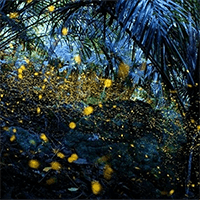- Age 0~Age 100
- 1~2 hours
- 18:00
You can enjoy the fantastically lit up 140-year-old townhouse, a cultural asset. The townhouse is lit up in hopes of ending the COVID-19 pandemic. Handmade lights made with an abundance of Japanese materials, such as washi paper, wood, and sake barrels, warmly illuminate the six gardens. Please enjoy the illuminated townhouse (building and garden) to your heart's content. This course will serve you carefully prepared kaiseki cuisine. Enjoy delicious food along with the beautiful lighting.
- Age 13~Age 80
- 1~2 hours
- 11:00 / 14:00 / 16:00
[Experience the mysterious Kyoto] A seasonal event that brings in the fortune that Kyoto people are sure to do. Experience on a monthly basis! Kyoto, the sacred place of Japanese culture. Boasting a history of more than a thousand years, this town continues to carry out various customs, customs, events, and customs as wisdom for living that has been preserved and passed down from ancient times. Evil, demons, mononoke, demons, and the magic that is unique to the people living in Kyoto who have coexisted with them, are required more than ever in the modern age of corona. For example ... How to spend the day of Setsubun to get rid of evil, the meaning of celebrating like a playhouse at the Hinamatsuri, how to pray when the inside of the house is noisy, etc. A lot of cute, mysterious and mysterious seasonal events at the turning point. They are the roots of events that are familiar to modern life. "Obon is a memorial service for ancestors." "At the time of Gion Matsuri, it's good to call it a sweets." I would like you to experience the true face of Kyoto, which has been passed down as a matter of course. This course is especially popular with women, but it is also recommended for couples. January: Kyoto's New Year's greetings welcome Toshigami-san, who grants happiness February: Kyoto's festival, defeating demons with a "shouldered sword" March: Hinamatsuri is a woman's self-polishing April: Cherry blossom viewing Communication with the gods May: Cut off the devil with irises and hoses June: Secretly "Natsukoshi no Harae" at home July: Gion Festival is a Shinto ritual to disperse the plague that has continued since the Heian period August: Enjoy scary and scary Kyoto September: The festival of chrysanthemums (Shigeyo) that polishes the beauty of women October: Jyugoya and Jusanya Have the moon grant their wishes. November: Power charge with red sword December: Shizuru's manners End the old year and receive the New Year's fortune <About Kyoto Wabichakai> Takagamine, the northern part of Kyoto. About 8 minutes on foot from Koetsuji Temple and Genko-an. The "Kyoto Wabi Tea Party" is held in a tea room quietly nestled along the river in an old inn surrounded by trees. In the forest that leads to the foot of Mt. In spring, you will be surrounded by dazzling fresh greenery, and at nightfall, fireflies will be in your room. In the summer, you can enjoy the private riverbed at the upper reaches of the Kamiya River, which flows beside the tea room where the dragon god lives. Surrounded by the nature of Kyoto, we will talk about the wisdom of traditional Kyoto seasons, events and customs, and beautiful monthly customs so that you can experience them. There are places in Kyoto that you want to visit many times, such as shrines and temples. However, it is not possible to know Kyoto by itself. Kyoto is a town where you can enjoy yourself deeply by facing the beauty and way of life of the Kyoto people who have protected them. Please enjoy Kyoto, which is a private place, away from the hectic daily life, where you can experience the heart of the ancient city, which is deep and graceful, which is not found in tourist spots.
- Age 0~Age 100
- 1~2 hours
- 11:00 / 13:00
A very popular traditional bento served at tea parties that has been passed down for about 100 years. Bento is a menu that has been passed down at Tomidaya for 100 years. A tour of the townhouse, which is a cultural property, is also included. We will show you around the 140-year-old townhouse "Tomitaya" in Nishijin, Kyoto. Tomidaya was designated as a nationally registered tangible cultural property in 1999, and as a ``Museum of Nishijin Life'', the building is open to the public and the customs of Nishijin, Kyoto are introduced. Machiya life has been shaped by unchanging prayers, wishes, and gratitude since ancient times. Tomidaya started out as a production wholesaler in Nishijin about 140 years ago. This building is built by mixing charcoal into the land and closing the demon gate with amulets and salt, and enshrines Kojin (the god of fire), Benten (the god of water), and Yaoyorozu gods. Masu. In addition, there is a treasure trove where the spirit of gratitude that the 11th generation received when he jumped into the fire and saved the deity during the great fire at Ise Jingu in the Meiji period is enshrined, and is used in daily life. We are here to show you the spirit of hospitality that lives on in the past, the spirit of valuing God, and the way people have lived through generations, such as drinking tea, dancing Noh, and valuing culture.
- Age 0~Age 90
- Within 1 hour
- 10:00 / 11:00 / 12:00 / 13:00 / 14:00 / 15:00 / 16:00
We handmade Nishijin weave Japanese goods one by one at the foot of Funaoka. Everyone of those "popular anime" fans must see! The original Wed or does not make the argument ornament! What? When you come to Funaoka Mountain, Kensuke Shrine, Imamiya Shrine, Daitokuji, come and visit us for making memories of the trip!
物覚えの悪い母子三人でお伺いしました。まさしく手取り足取り教えて頂き、本当に完成出来ました。ありがとうございました。星五つにしなかったのは、自宅でもう一度作れるように水引も頂いたのに、出来る自信が無いからです。すみません。
最近チェックしたプラン
Please wait a moment
![[Kyoto/Nishijin] Tomidaya Machiya Light-up Kaiseki Dinner [Includes Machiya Tour]の画像](https://img.activityjapan.com/10/36500/10000003650001_xyLMlfkE_3.jpg?version=1656039186)
![[Kyoto / Kinkakuji area] Experience the mysterious Kyoto! Monthly good luck magic that is handed down to Kyo, apotropaic magic, matchmaking! With exquisite namagashi!の画像](https://img.activityjapan.com/10/40206/10000004020601_hN8DMY4s_3.jpg?version=1641380945)
![[Kyoto/Nishijin] You can enjoy a 100-year-old traditional lunch box at a townhouse where the gods live (with tour of the townhouse)の画像](https://img.activityjapan.com/10/51578/10000005157801_aIipu863_3.jpeg?version=1698287285)








